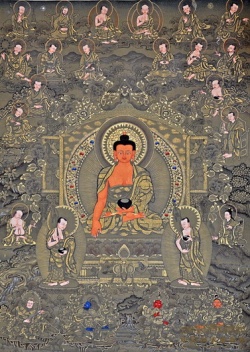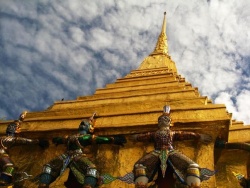Difference between revisions of "Shankaracharya and Buddhism"
m (Text replacement - "ultimate bliss" to "ultimate bliss") |
m (Text replacement - "]]]" to "]])") |
||
| (One intermediate revision by the same user not shown) | |||
| Line 71: | Line 71: | ||
In this connection, the AlayavijnAna of the vijnAnavAdins may come into question. It is the [[substratum]] of transmigratory [[existence]] assumed by them and corresponds to the unchangeable [[substratum]], that is, the [[Atman]] of the fourth stage whose [[existence]] is strongly asserted by the [[Shankara]] school. Shankara’s critique against this AlayavijnAna is found in his brahmasUtrabhAShya: | In this connection, the AlayavijnAna of the vijnAnavAdins may come into question. It is the [[substratum]] of transmigratory [[existence]] assumed by them and corresponds to the unchangeable [[substratum]], that is, the [[Atman]] of the fourth stage whose [[existence]] is strongly asserted by the [[Shankara]] school. Shankara’s critique against this AlayavijnAna is found in his brahmasUtrabhAShya: | ||
| − | “In the vijnAnavAda [[doctrine]], the so-called AlayavijnAna is by mistake considered to be the [[substratum]] of residual [[impressions]] and also being admittedly momentary, this AlayavijnAna is [[essentially]] something unstable, and similar to the active [[conciousness]] (pravrttivijnAna); it can never be the [[substratum]] of residual [[impressions]]. This is because unless there [[exists]] one persistent [[entity]] which is equally connected with the {{Wiki|past}}, the {{Wiki|present}}, and the {{Wiki|future}}, or an absolutely unchangeable | + | “In the vijnAnavAda [[doctrine]], the so-called AlayavijnAna is by mistake considered to be the [[substratum]] of residual [[impressions]] and also being admittedly momentary, this AlayavijnAna is [[essentially]] something unstable, and similar to the active [[conciousness]] (pravrttivijnAna); it can never be the [[substratum]] of residual [[impressions]]. This is because unless there [[exists]] one persistent [[entity]] which is equally connected with the {{Wiki|past}}, the {{Wiki|present}}, and the {{Wiki|future}}, or an absolutely unchangeable ([[eternal]] [[Atman]]) which [[Wikipedia:Cognition|cognizes]] everything, then we are unable to account for daily [[activities]] like [[memory]] and [[recognition]] which are [[subject]] to residual [[impressions]] dependent on place, [[time]] and [[cause]]. On the other hand, if you declare your AlayavijnAna to be by [[nature]] [[permanent]], you thereby abandon your tenet [of the AlayavijnAna as well as everything else being momentary]”. |
The vijnAnavAdins [[recognize]] the AlayavijnAna as the [[substratum]] of residual [[impressions]], but as they accept its momentariness, [[Shankara]] denies the possibility of its being the [[substratum]]. In Shankara’s [[view]] our daily [[activities]] like [[memory]] and [[recognition]] would presuppose the [[existence]] of a continuos [[entity]] (anvayin) that persists in all the three times, {{Wiki|past}}, {{Wiki|present}} and {{Wiki|future}}, or else, an unchangeable, [[permanent]] (kUTashthanitya), quiescent [[Atman]]. Therefore, this [[Atman]] is [[essentially]] different from the AlayavijnAna. | The vijnAnavAdins [[recognize]] the AlayavijnAna as the [[substratum]] of residual [[impressions]], but as they accept its momentariness, [[Shankara]] denies the possibility of its being the [[substratum]]. In Shankara’s [[view]] our daily [[activities]] like [[memory]] and [[recognition]] would presuppose the [[existence]] of a continuos [[entity]] (anvayin) that persists in all the three times, {{Wiki|past}}, {{Wiki|present}} and {{Wiki|future}}, or else, an unchangeable, [[permanent]] (kUTashthanitya), quiescent [[Atman]]. Therefore, this [[Atman]] is [[essentially]] different from the AlayavijnAna. | ||
Latest revision as of 02:56, 5 April 2016
It is well-known that Shankara is criticized by his opponents as a “Buddhist in disguise” (pracChannabauddha) and his philosophy as mAyAvAda which is but crypto-Buddhism.
Among the vedAntins, bhAskara (750-800) is probably one of the earliest critics against Shankara. He called the mAyAvAdin as “one who depends on the doctrine of the Buddhist” (bauddhamatAvalambin), and says that this position has been negated by the author of brahmasUtra. Afterwards, yAmuna (918-1038), rAmAnuja (1017-1037), madhva (1197-1276), vallabha (1473-1531) and other vedAntins severely criticized Advaita vedAnta, pointing out that it is in essence nothing but a Buddhist doctrine.
Then, in the later part of the sixteenth century, VijnAnabhikShu of the sAmkhya school shows in his sAmnkhyapravachanabhAShya that the mAyAvAda of the vedAntins is of the same standpoint as that of the vijnAnavAdin’s and criticizes the vedAnta school as a whole. In justifying his criticism, he quotes a verse from the padmapurANa which states that the mAyAvAda is an incorrect theory and is Buddhist doctrine.
mAyAvAdamasacChAstraM pracChannaM bauddhameva cha | mAyaiva kathitaM devi kalau brAhmaNarUpiNe ||
VijnAnabhikShu quotes this verse twice in his sAmkhyapravachanabhAShya.
This is true of modern scholars. For example, in his A History of Indian Philosophy, S Dasgupta remarks:
“Shankara and his followers borrowed much of their dialectic form of criticism from the Buddhists. His Brahman was very much like the shUnya of specifically nAgArjuna. I am led to think that shankara’s philosophy is largely a compound of vijnAnavAda and shUnyavAda Buddhism with the upaniShad notion of the permanence of self superadded”.
Thus, he supports vijnAnabhikShu’s criticism against mAyAvAda.
Even S Radhakrishnan who asserts that “there is no doubt that Shankara develops his whole system from the upaniShads and the vedAnta sUtra without reference to Buddhism”, says the following:
“We need not say that the Advaita vedAnta philosophy has been very much influenced by the mAdhyamika doctrine. The nirguNa Brahman of Shankara and nAgArjuna’s shUnya have much in common”.
Shankara, however, vehemently attacks Buddhism here and there in his BrahmasUtrabhAShya, BrhadAraNyakabhAShya, UpadeshasAhasrI and his other works. What is Buddhism for him and his philosophy?
Around the fifth century when Vasubandhu (400-480) was active, there were four major schools in Indian Buddhism; they were the SarvAstivAdin, the SautrAntika, the mAdhyamika and the YogAchAra or VijnAnavAdin. It was also the common practice in the Indian philosophical schools in general to distinguish four Buddhist schools when they treated Buddhism. Shankara however, in his BrahmasUtrabhAShya (II,2,18), criticizes the the following three different types of Buddhist propounders:
sarvAstitvavAdin or one who asserts the real existence of everything. VijnAnAstitvavAdin or one who asserts the real existence of consciousness. SarvashUnyatvavAdin or one who asserts the emptiness of everything.
He keeps silent about any other Buddhist propounders but if we are to judge from vAchaspatimishra’s commentary bhAmatI on the BrahmasUtrabhAShya, we can infer that the first propounder SarvAstivAdin points not only to the sarvAstivAdin but also include the sautrAntika. The second and the third propounders clearly refer to the vijnAnavAdin and the mAdhyamika respectively. Therefore, it may be possible for us to see Shankara’s classification corresponding to that made in the general Indian philosophical treatises except the order of classification.
It is indeed certain that Shankara is well aware of the terms mAdhyamika and vijnAnavAdin since he uses these terms in his own works when he surveys Buddhist positions. Nevertheless, why does he use in the above instance of his BrahmasUtrabhAShya the terms sarvAstitvavAdin, vijnAnAstitvavAdin and sarvashUnyatvavAdin, other instances of which cannot be found elsewhere? He gives no explanation of these terms at all. Why does he not use such names as mAdhyamika and vijnAnavAdin?
It seems that the context where Shankara criticizes other schools including the above Buddhists gives us a clue to solve this problem. Before Shankara begins to criticize the three kinds of Buddhist schools, he takes up the vaisheShika school for his sharp criticism and characterizes it as ardhavainAshika or semi-nihilism. In this connection he cclassifies Buddhism as sarvavainAshikarAddhAnta or the doctrine which asserts the nihilism of everything, and it is after this that he undertakes the above classification of the Buddhist schools. In other words, in his understanding the philosophical school which bears the name of vaisheShika is characterized as semi-nihilism, and similarly in the case of Buddhism, he presents his understanding of Buddhism in general as that doctrine which asserts the nihilism of everything.
From the above observation we can safely infer that in treating the three types of Buddhist schools, Shankara intended to express the specific character of the particular Buddhist school in a word succinctly as in the case of the vaisheShika school and that for this reason he did not use the usual names of the schools like mAdhyamika. In short Shankara is not simply enumerating the names of the Buddhist schools but is making an attempt at critical classification of the doctrines from his own philosophical standpoint.
It is to be noted here that the description of the characteristics of the three Buddhist schools, terms astitva and shUnyatva which have to do with reality or ontological judgment are employed. Shankara makes his classification based on the criterion of what is asserted as real, or in other words, from his ontological point of view. He applies this criterion to each Buddhist school and in his attempt to present coherent expressions, his use of the terms sarvAstitvavAdin, vijnAnAstitvavAdin and sarvashUnyatvavAdin are indeed appropriate.
If the same criterion is to be applied to Buddhism as a whole, Buddhism would come down to sarvavainAshikarAddhAnta or that doctrine which asserts the nihilism of everything. This is because, not to mention sarvashUnyatvavAdin, the vijnAnavAdin as well as the sarvAstitvavAdin asserts the theory of kShaNabhanga or that of entities having but momentary existence and therefore, in Shankara’s understanding, Buddhism as a whole is a doctrine which asserts total nihilism.
Also, in explaining why there is plurality of Buddhist positions, Shankara points out the difference in disciples’ innate ability of understanding (pratipattibheda) and says as follows:
“the doctrine of the reality of the external world (bAhyArthavAda) was indeed propounded by the Buddha conforming himself to the mental state of some of his disciples whom he perceived to be attached to external things; but it does not represent his own true view (saugatAbhiprAya) according to which consciousness alone is real (vijnAnaikaskandha)”.
For Shankara, even that Buddhist theory which asserts that consciousness alone is real is nihilistic without a morsel of rationality. Shankara adds that it is not possible to lead one’s ordinary life on the basis of such a nihilistic view.
And finally he concludes his criticism against the Buddha and Buddhism with the following words:
“No further special discussion is in fact required. Form whatever new points of view the Bauddha system is tested with reference to its probability, it gives way on all sides, like the walks of a well dug in sandy soil. It has, in fact, no foundation whatever to rest upon, and hence the attempts to use it as a practical guide in the practical concerns of life are mere folly. Moreover, Buddha by propounding the three mutually contradictory systems, teaching respectively the reality of external world, the reality of consciousness alone and total nihilism, has himself made it clear that he was a man given to make incoherent assertions, or else that hatred of all beings induced him to propound absurd doctrines by accepting which they would become thoroughly confused. Buddha’s doctrine has to be entirely disregarded by all those who have a regard for their own happiness”.
As I have already mentioned, there appeared many critics against Shankara and his followers. It is very probable that those critics appeared not only after his death but also during his lifetime. In fact, Shankara himself explicitly admits in his mANDUkyopaniShad kArikAbhAShya that Buddhism is said to be in close similarity to the Advaita of his paramaguru gauDapAda:
“This knowledge regarding the Ultimate Reality, non-dual and characterized by the absence of the difference of knowledge, object of knowledge and knower, is not the same as that declared by the Buddha. The view of the Buddha which rejects the existence of external objects and asserts the existence of consciousness alone, is said to be similar to or very near the truth of non-dual Atman. But this knowledge of the non-dual which is the Ultimate Reality can be attained through vedAnta alone”.
Here in this passage Shankara recognizes the Buddhists’ denial of the real existence of the external objects and their acceptance of the real existence of consciousness only as the points of similarity of Buddhism, which is the doctrine of the vijnAnavAdin in this case, to the truth of non-dual Atman of vedAnta.
On the other hand, critics against Buddhism like VijnAnabhikShu also criticize as the point of similarity between Advaita and Buddhsim that assertion of both schools regarding the non-real existence of the external objects or of the non-reality of the phenomenal world. This view, also called mAyAvAda, is that very point with regard to which Shankara also admits that the Advaita vedAnta is criticized as similar to Buddhism. This is an important problem which touches on the very basis of the two schools.
It is indeed true as described above that, if both the Advaitins and the Buddhists equally assert the non-reality of the phenomenal world, then nobody can deny that the severe criticism that advaita is same as or similar to to the Buddhist doctrine is well-founded. However, Shankara and his followers have rejected their opponents’ criticism, emphasizing their own originality.
In the case of Shankara, as is seen in the above quoted passage from his mANDUkyopaniShatkArikAbhAShya, he finds the Advaitins’ originality in the following two points: firstly the Advaita philosophy expounds the non-dual, Ultimate Reality which, unlike the vijnAnavAdin’s vijnAna consisting of three components i.e., knowledge, object of knowledge and knower, does not possess any components like those, and secondly the Advaita philosophy is based on the absolute authority of the upaniShads. It is on the same points that sarvajnAtman sees the difference between the vedAntins and the vijnAnavAdins in his samkShepashArIraka (II, 27-38).
When Shankara and his followers attack the vijnAnavAdins, ultimately the above two points, especially the point that the vijnAnavAdins do not recognize an eternal, unchangeable Atman, are the target of criticism. Likewise in the case of Shankara’s negation of the mAdhyamika philosophy, he shows the difference between the mAdhyamikas and his own position in the fact that the mAdhyamikas do not accept the basis of reality which is the Atman of the fourth stage and, for this reason, criticizes the doctrine of shUnyatA or emptiness.
Also, padmapAda (720-770), one of shankara’s disciples, alludes to the doctrine of shUnyatA in the expression “niradhiShThAnAdhyAsavAdipakSha” or the standpoint of the propounder who asserts that the superimposition (adhyAsa) has no foundation, and criticizes this point of the doctrine of shUnyatA.
In this way, the attacks against the mAdhyamikas are based on the point that it does not accept an eternal unchangeable reality which lies in the background as the foundation of the phenomenal world. Even those hInayana schools which recognize the reality of objects of the external world do not differ from the mAdhyamikas and the vijnAnavAdins at all according to Shankara since they do not recognize a permanent substratum as far as they hold the theory of entities having but momentary existence. As such, all Buddhist doctrines are nothing but nihilistic doctrines (vainAshika) “not to be taken into serious consideration by those who are seeking ultimate bliss”.
In this connection, the AlayavijnAna of the vijnAnavAdins may come into question. It is the substratum of transmigratory existence assumed by them and corresponds to the unchangeable substratum, that is, the Atman of the fourth stage whose existence is strongly asserted by the Shankara school. Shankara’s critique against this AlayavijnAna is found in his brahmasUtrabhAShya:
“In the vijnAnavAda doctrine, the so-called AlayavijnAna is by mistake considered to be the substratum of residual impressions and also being admittedly momentary, this AlayavijnAna is essentially something unstable, and similar to the active conciousness (pravrttivijnAna); it can never be the substratum of residual impressions. This is because unless there exists one persistent entity which is equally connected with the past, the present, and the future, or an absolutely unchangeable (eternal Atman) which cognizes everything, then we are unable to account for daily activities like memory and recognition which are subject to residual impressions dependent on place, time and cause. On the other hand, if you declare your AlayavijnAna to be by nature permanent, you thereby abandon your tenet [of the AlayavijnAna as well as everything else being momentary]”.
The vijnAnavAdins recognize the AlayavijnAna as the substratum of residual impressions, but as they accept its momentariness, Shankara denies the possibility of its being the substratum. In Shankara’s view our daily activities like memory and recognition would presuppose the existence of a continuos entity (anvayin) that persists in all the three times, past, present and future, or else, an unchangeable, permanent (kUTashthanitya), quiescent Atman. Therefore, this Atman is essentially different from the AlayavijnAna.
Shankara’s Atman and the vijnAnavAdin’s AlayavijnAna each arose from different backgrounds and long historical traditions. Even if they differ in essence, they show mutual similarity in their function that they exercise within each system, and as both of the two systems equally assert the non-reality of the phenomenal world, they both belong to a similar monistic standpoint.
In this context, it is quite interesting to note the following fact. Buddhist philosophers, ShAntarakShita (725-788) and KamalashIla (740-796), point out that there is a “slight mistake” (alpAparAdha) in the Advaita, in other words, the difference between their own and the Advaita standpoint, which lies in their understanding of the nature of vijnAna; seen from the side of Buddhism, the difference or the originality of each lies in the understanding of the nature of vijnAna and of Atman, pure consciousness. The Buddhist side criticizes the eternal nature of the Atman while the vedAnta side attacks the momentariness of vijnAna. This is the last line on which neither side could by any means concede to the other from the theoretical point of view.
Then, how has the vedAnta school, which is representative of the orthodox Brahminical (Astika) traditions, come to assume close similarities to Buddhism, which is representative of the non-orthodox (nAstika) traditions?
The vedAntinization of Buddhism did not start just at the time of shAntarakShita and kamalashIla. As is well known, in the LankAvatArasUtra, which was probably composed around the year 400 A.D., tathAgatagarbha or the matrix-embryo of the tathAgata was not only at times identified with AlayavijnAna, but the definition of this tathAgatagarbha was also very similar to the definition of brahman in the vedAnta. Besides, brahman, viShNu, and Ishvara are also used as synonymns of tathAgata and the highest brahman comes to be regarded as the ultimate state. In the same sUtra, mahAprajnA bodhisattva raises the question to the Buddha as to whether the doctrine of the tathAgatagarbha is not the same as the heretical Atman doctrine (tIrthakarAtmavAda).
The question, of course, needs a further detailed investigation, but it seems to me that even though Buddhism had long been taking the doctrinal standpoint of denying the existence of Atman, Buddhism was gradually in the process of moving towards monism, negating pluralism of the hInayAna Buddhism, especially the sarvAstivAdins, and included such notions as tathAgatagarbha and AlayavijnAna into the Buddhist doctrines; the inclusion of such notions reveals to us the weakening of Buddhism as a social force and the revival of Brahmanism and the consequent Brahmanization or vedAntinization of Buddhism. The tendency towards a monistic way of thinking is one great current that runs through the orthodox line of the history of Indian thought from the time of Rgveda.
On the other hand, the vedAnta school was formed with the brahmasUtra as its foundation in the fifth century, comparatively later than other philosophical schools including the Buddhist schools. The vedAnta school established a system of Brahmanic monism based upon the upaniShads, and especially in reacting to the then rather influential sAmkhya school.
However, this realistic monism of the brahmasUtra was of a character of bhedAbheda or dualistic monism, as it were. In denying such a standpoint and in the process of developing towards an absolute monism (advaita), that is, the upaniShadic thought of the identity of brahman and Atman, the realistic monism of the brahmasUtra was gradually transformed and moved closer and closer to the Buddhism which had a more advanced theoretical system than the vedAnta. While doing so, this vedAnta philosophy came to be “buddhisticized” considerably.
The gradual process of buddhisticization of the vedAnta school is reflected in the four chapters of the mANDUkyakArikA of gauDapAda (640-690) in the seventh century. This buddhisticization of the vedAnta school reached its highest point in the fourth chapter of this work.
What Shankara, born in South India in the eighth century, found before him were: firstly the mImAmsA school which was very flourishing with excellent theoreticians like kumArila (650-700), prabhAkara (700), maNDanamishra (680-720) and others; secondly, a big wave of popular Hinduism which penetrated in leaps and bounds through the masses, and thirdly, a weakening, esoteric-oriented Buddhism which was the target of strong criticisms of kumArila and others; fourthly, a thoroughly buddhisticized vedAnta school.
Aiming at the revival of the vedAnta school from the standpoint of orthodox Brahmanism, Shankara practically almost ignored popular Hinduism which stressed bhakti, heaped severe criticism against the mImAmsA school which had no interest in the knowledge of the brahman at all, breaking the former close relationship between the mImAmsA and the vedAnta schools, and devoted himself to the knowledge of brahman which is the most important topic of the upaniShads. On the other hand, vis-a-vis Buddhism, using his profound knowledge of Buddhism, he transmuted Buddhist doctrines in the mANDUkyakArikA into Advaita; in other words, he re-injected the upaniShadic spirit into the extremely buddhisticized mANDUkyakArikA of his paramaguru, pouring new life into it as it were, giving it an interpretation that followed the line of vedAnta school and achieved the re-vedAntinization of the buddhisticized vedAntic tradition.
In this way, Buddhist doctrines, which had been absorbed into the pre-Shankaran vedAnta philosophy and constituted an integral part of the mANDUkyakArikA, were preserved without being removed and were vedAnticized by Shankara. As the result, the realistic monism of the brahmasUtra was transformed and developed into an illusionistic non-dualism which, as he himself recognized, closely resembled the Buddhist doctrine.
From the above discussions, it may now be clear that Shankara is neither responsible for the buddhisticization of the vedAnta nor is a “Buddhist in disguise”. It might be gauDapAda the author of the mANDUkyakArikA, or his predecessors, and not Shankara who can be called a ‘Buddhist in disguise’. For Shankara, Buddhism is an important target to overcome. For this reason, he attacks it very severely in his works. Shankara was an epoch-making reformer in the history of vedAnta who turned the extremely buddhisticized tradition of vedAnta towards the vedAntic or upaniShadic vedAnta.







